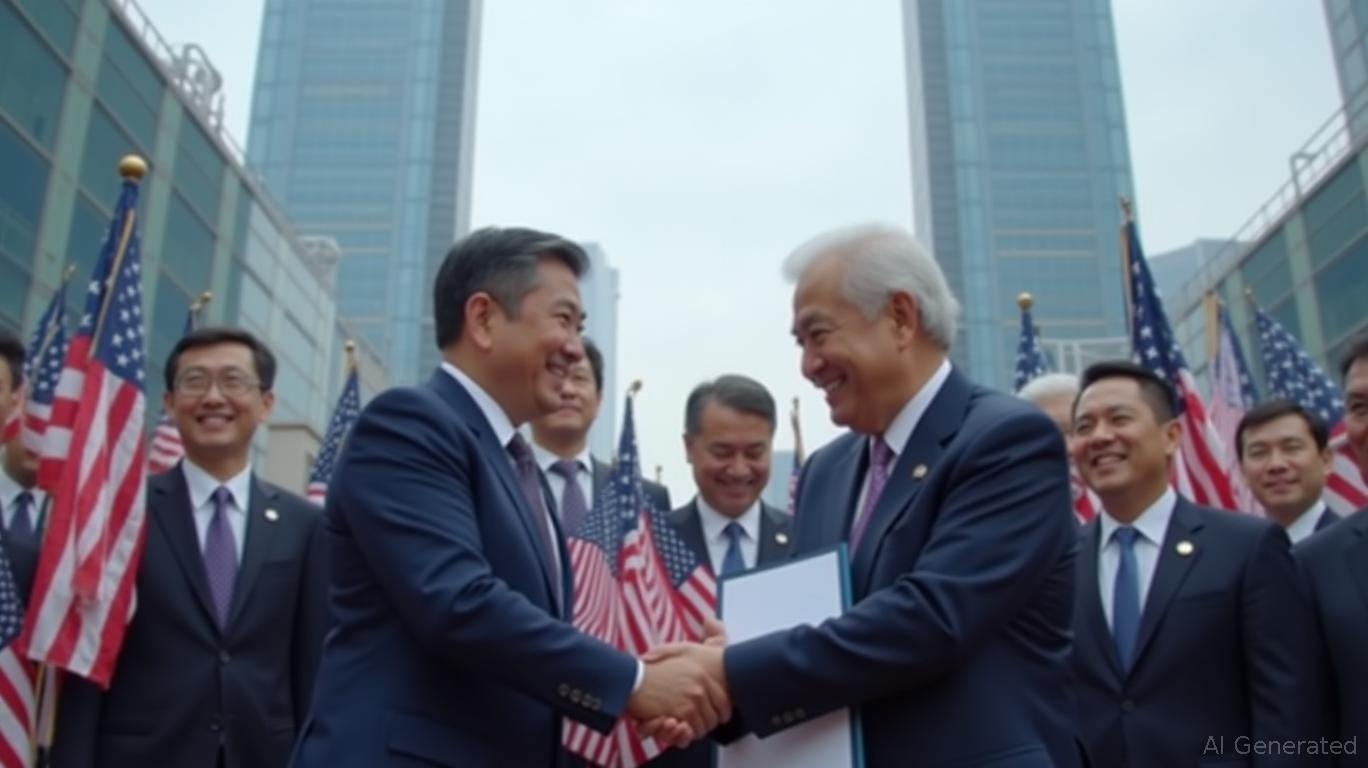Balancing Duties and Heritage: U.S.-South Korea Agreement Reinforces Partnership as Trade Dynamics Evolve
- South Korea and Trump secured a trade deal cutting auto tariffs to 15% and a $350B investment pact during APEC, resolving a dispute threatening Seoul's export-driven economy. - The agreement includes $200B annual cash infusions and $150B U.S. shipbuilding cooperation, addressing Seoul's foreign exchange concerns while linking U.S. energy/defense sector commitments. - Symbolic gifts like the Silla crown and Mugunghwa medal highlighted historical diplomacy, with Lee framing the deal as strengthening U.S.-S
South Korea’s diplomatic gestures toward President Donald Trump—including presenting a gold-plated replica of a Silla Dynasty crown and bestowing the country’s highest national honor—helped spark a breakthrough in previously stalled trade talks. During Trump’s official visit to Gyeongju for the APEC summit, both countries agreed to reduce auto tariffs from 25% to 15% and finalized a $350 billion investment deal, settling a dispute that had threatened South Korea’s export-reliant economy, according to a
The investment plan includes $200 billion in annual cash investments, limited to $20 billion per year, and $150 billion dedicated to collaboration in U.S. shipbuilding, addressing Seoul’s earlier worries about draining its foreign currency reserves, according to

The symbolic acts during the negotiations—such as awarding the Grand Order of Mugunghwa and gifting the Cheonmachong crown—highlighted South Korea’s strategy of blending historical diplomacy with economic interests. Lee gave Trump the crown, a reproduction of a 9th-century Silla relic representing “peace and leadership,” during a museum tour in Gyeongju, presenting it as a gesture toward shared goals for regional peace, as a
This pact also relieves some of the competitive pressure South Korea faces from Japan and Europe, which had already secured lower U.S. tariffs. By matching the 15% auto tariff, South Korea gains time to update its automotive sector while keeping its status as the third-largest Asian trading partner of the U.S., a
Nonetheless, some critics argue that the deal’s reliance on non-cash elements—like shipbuilding—may limit immediate economic benefits. Shin Se-don, an economics professor at Sookmyung University, questioned whether the investment plan would be enough to counterbalance the higher tariffs on steel and aluminum, which remain at 50%, as Firstpost reported. Despite these concerns, both governments expressed satisfaction: Trump called the deal a victory for “American workers,” while Lee highlighted its importance in solidifying the U.S.-South Korea partnership amid shifting regional dynamics, according to the South China Morning Post.
Disclaimer: The content of this article solely reflects the author's opinion and does not represent the platform in any capacity. This article is not intended to serve as a reference for making investment decisions.
You may also like
"From Initial Coin Offerings to Gaining Institutional Confidence: The Transformation of Crypto Tokenomics"
- Canton’s tokenomics strategy rejects ICOs, promoting structured, long-term crypto development models to enhance institutional credibility and sustainability. - Regulatory delays like Switzerland’s postponed CARF and U.S. ETF approvals highlight challenges in aligning innovation with compliance and cross-border legitimacy. - Grayscale’s Dogecoin and XRP ETFs signal growing institutional acceptance, though mixed market performance underscores crypto’s volatility and speculative risks. - Advocacy groups lik

ETPs Connect Speculative Tokens with Traditional Financial Markets
- Swiss firm Bitcoin Capital launched Europe's first Bonk ETP on SIX, enabling traditional investors to trade the Solana-based memecoin via conventional financial tools. - Physically-backed ETP eliminates crypto expertise requirements, aligning with global altcoin product surges and U.S. altcoin ETF trends. - Market shift toward speculative assets reflects regulatory clarity and institutional interest, with European regulators cautiously embracing crypto-ETP bridges. - Projects like Kuardun7.0 aim to merge

The transformation of the Xerox campus in Webster, NY: A calculated move in real estate and infrastructure development
- Webster , NY's Xerox campus redevelopment leverages a $9.8M FAST NY grant to upgrade 300 acres of brownfield infrastructure, creating shovel-ready industrial space by 2025. - Xerox's strategic divestiture aligns with infrastructure timelines, enabling private-sector repurposing of the site as a mixed-use hub with anchor projects like the $650M fairlife® dairy plant. - State-backed upgrades have already driven 10.1% annual home price growth and 2% industrial vacancy rates, positioning the site to capture

Ethereum News Update: Amundi’s Integrated Approach Connects Blockchain with Conventional Financial Regulations
- Amundi, Europe's largest asset manager, launched its first Ethereum-based tokenized money-market fund, enabling 24/7 settlements and transparent record-keeping via blockchain. - The hybrid model, developed with CACEIS, combines traditional fund operations with blockchain-based ownership, preserving regulatory compliance while expanding investor access. - Ethereum's dominance in stablecoin and RWA transfers ($105.94B in 30 days) underscores its role in accelerating tokenization, with Amundi positioning it
